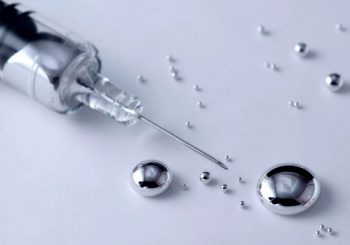By Sayer Ji
Contributing writer for Wake Up World
Garlic is used the world over as a culinary spice, but recent research indicates that among its 100+ medicinal properties it is far safer and more effective than a commonly used chelation drug in pulling lead out of the human body.
A remarkable study published in the journal Basic & Clinical Pharmacology & Toxicology revealed something very special about garlic: it is a natural detoxifier of lead and is not only as effective as a common chelation drug known as d-penicillamine at pulling this metal out of the body but is also much safer.
The study was titled, “Comparison of therapeutic effects of garlic and d-penicillamine in patients with chronic occupational lead poisoning,” and sought to confirm previous research in animals that showed garlic (Allium sativum) is effective in reducing blood and tissue lead concentrations.[1]
The study took the measurements of the blood lead concentrations of 117 workers at a car battery plant who were randomly assigned to two groups of garlic (1.2 milligrams of allicin from approximately 1,000 mg of garlic extract, three times daily) and d-penicillamine (250 mg, three times daily) and treated for 4 weeks. Clinical signs and symptoms of lead poisoning were also investigated and compared with the initial findings.
The study found:
“Clinical improvement was significant in a number of clinical manifestations including irritability (p = 0.031), headache (p = 0.028), decreased deep tendon reflex (p=0.019) and mean systolic blood pressure (0.021) after treatment with garlic, but not d-penicillamine. BLCs [blood lead concentrations] were reduced significantly (p=0.002 and p=0.025) from 426.32±185.128 to 347.34±121.056?g/L and from 417.47±192.54 to 315.76±140.00?g/L in the garlic and d-penicillamine groups, respectively, with no significant difference (p=0.892) between the two groups. The frequency of side effects was significantly (p=0.023) higher in d-penicillamine than in the garlic group. Thus, garlic seems safer clinically and as effective as d-penicillamine. Therefore, garlic can be recommended for the treatment of mild-to-moderate lead poisoning.”
Clearly, despite the near equal reduction in measurable blood lead concentrations in both groups, improvements in various measured clinical manifestations were only found in the garlic group. Also, side effects were higher in the d-penicillamine group. These results clearly indicate the superiority of garlic over the drug and underscore how drug-based interventions often end up ‘normalizing’ target values, e.g. blood lead concentrations, without resulting in improvement in the quality of life or even the objective clinical signs and subjective symptoms of the treated patient; to the contrary, often the patient feels and is much worse off following drug treatment.
Lead exposure is ubiquitous in our modern age, and has been estimated to account for approximately 0.2% of all deaths and 0.6% of disability adjusted life years globally.[2]Exposure to this heavy metal results in harm to the cardiovascular, skeletal, gastrointestinal, kidney, reproductive and nervous systems of the human body. It has been identified to be particularly harmful to infants and children, whose developing nervous systems are far more susceptible to lead toxicity than those of adults. In fact, a 2008 PLoS study found decreased brain volume in adults who had been exposed to lead as children.[3]
The standard of care involving drugs such as d-penicillamine is dismal, considering that the chemical has been linked to the following side effects:
- Anemia, Aplastic
- Breast Enlargement
- Anorexia
- Bone Marrow Suppression
- Collagen Disorders
- Diarrhea
- Dysgeusia (distorted taste)
- Kidney Damage
- Liver Damage
- Muscle Damage
The chemical is so toxic that the total incidence of side effects from d-penicillamine treatment is 30-60%, with a withdrawal rate of 20-30%.[4]
Garlic, on the other hand, is a commonly enjoyed culinary spice worldwide with a wide range of potential side benefits and a high margin of safety. In a previous article titled, How Garlic Can Save Your Life, we discussed the sizable body of research gathered on the GreenMedInfo.com database on the over 150 health conditions garlic has been researched to be potentially beneficial for.
Additionally, our open access database project, which now contains over 3000 ailments indexed, has a section on “Lead Poisoning,” which includes research on 23 substances that may help ameliorate the effects of lead exposure and/or toxicity, and which can be viewed here: Natural Agents for Lead Poisoning.
Article sources:
- [1] Sina Kianoush, Mahdi Balali-Mood, Seyed Reza Mousavi, Valiollah Moradi, Mahmoud Sadeghi, Bita Dadpour, Omid Rajabi, Mohammad Taghi Shakeri. Comparison of therapeutic effects of garlic and d-Penicillamine in patients with chronic occupational lead poisoning. Basic Clin Pharmacol Toxicol. 2012 May ;110(5):476-81. Epub 2011 Dec 29. PMID: 22151785
- [2] Global health risks : mortality and burden of disease attributable to selected major risks. Geneva, Switzerland: World Health Organization. 2009. p. 24. ISBN 9789241563871.
- [3] Kim M Cecil, Christopher J Brubaker, Caleb M Adler, Kim N Dietrich, Mekibib Altaye, John C Egelhoff, Stephanie Wessel, Ilayaraja Elangovan, Richard Hornung, Kelly Jarvis, Bruce P Lanphear. Decreased brain volume in adults with childhood lead exposure. PLoS Med. 2008 May 27 ;5(5):e112. PMID: 18507499
- [4] K Grasedyck. [D-penicillamine–side effects, pathogenesis and decreasing the risks]. Z Rheumatol. 1988 ;47 Suppl 1:17-9. PMID: 3063003
Recommended articles by Sayer Ji:
- 6 Natural Ibuprofen Alternatives Backed by Clinical Research
- Dramatic Recovery In Parkinson’s Patient with Gluten Free Diet
- Turmeric’s Weight Loss Secret – It Turns Bad Fat Good
- Brain Regeneration: Why It’s Real and How To Do It
- Research: Garlic is an Effective Natural Treatment for Heart Disease
- Wi-Fi Devices Increase Mercury Release From Dental Amalgams
- Mammography Is Harmful and Should Be Abandoned, Scientific Review Concludes
- “Killer Germs” Obliterated by Medicinal Smoke Smudging, Study Reveals
- Turmeric’s ‘Smart Kill’ Properties Put Chemo & Radiation To Shame
- Beet Juice Boosts Cognitive Function In One Dose
- The Amazing Healing Properties of Apples
- 6 Bodily Tissues That Can Be Regenerated Through Nutrition
- How to Clean Your Arteries With One Simple Fruit
About the author:
Sayer Ji is the founder of Greenmedinfo.com, a reviewer at the International Journal of Human Nutrition and Functional Medicine, Co-founder and CEO of Systome Biomed, Vice Chairman of the Board of the National Health Federation, and Steering Committee Member of the Global Non-GMO Foundation.
For more, visit GreenMedInfo.com and Facebook.com/GreenMedInfo, or sign up for GreenMedInfo’s free e-Newsletter.
© January 31st, 2019 GreenMedInfo LLC. This work is reproduced and distributed with the permission of GreenMedInfo LLC. Want to learn more from GreenMedInfo? Sign up for their newsletter here.

If you've ever found value in our articles, we'd greatly appreciate your support by purchasing Mindful Meditation Techniques for Kids - A Practical Guide for Adults to Empower Kids with the Gift of Inner Peace and Resilience for Life.
In the spirit of mindfulness, we encourage you to choose the paperback version. Delve into its pages away from screen glare and notifications, allowing yourself to fully immerse in the transformative practices within. The physical book enriches the learning process and serves as a tangible commitment to mindfulness, easily shared among family and friends.
Over the past few years, Wake Up World has faced significant online censorship, impacting our financial ability to stay online. Instead of soliciting donations, we're exploring win-win solutions with our readers to remain financially viable. Moving into book publishing, we hope to secure ongoing funds to continue our mission. With over 8,500 articles published in the past 13 years, we are committed to keeping our content free and accessible to everyone, without resorting to a paywall.








